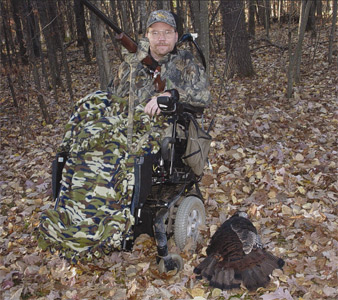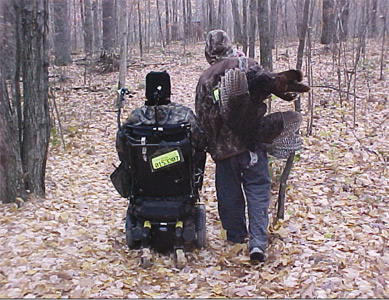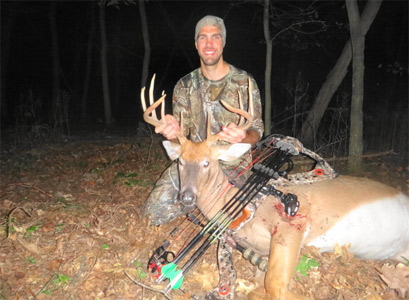ADAPTIVE TECHNIQUES CAN HELP HUNTERS WITH MS
 |
For Immediate Release Contact: Maureen Waslicki |
(WISCONSIN) – Even among the amazing tales all deer hunters seem to tell, Don Christensen has bragging rights most others don’t: he shot six deer in the past six years – using his mouth.
The 47-year-old married father of two is an avid outdoorsman and experienced hunter. A quadriplegic since progressive-relapsing multiple sclerosis sapped his ability to use his arms and legs, he uses a sip-and-puff trigger system to fire both his .243 rifle and Ten-Point crossbow with his mouth.
He admits the .243 “is kind of a ladies or kids rifle” for someone who has been hunting since he was seven, “but if I put my old 30-06 up, (the recoil) would knock my front teeth out.” Adaptive hunting tips such as that – based on years of experience coupled with keen ingenuity – are the basis of afarcry.info, the website Christensen founded to help people with disabilities access the outdoors.
 |
 |
| Using a sip-and-puff trigger system with both a rifle and a crossbow gives Don Christensen the ability to continue hunting. He posts resources and tips on adaptive hunting on his website, afarcry.info. | Don’s son Riley helped him during the fall turkey season in 2006 and is still by his side each year during Wisconsin’s disabled hunt. |
The name “A Far Cry” came from a comment a friend made after Christensen’s MS progressed to where he had to give up a teaching job he loved, go on disability and face the very real possibility that he would never hunt again. “He said, ‘You can’t do things the way you used to, but what you do is a far cry from sitting on the couch watching hunting shows and wishing,’” Christensen recalled.
That friend also helped Christensen become the Disabilities Coordinator for Babe Winkelman Productions, finding hunting and fishing outfitters that can accommodate disabled sportspeople.
He was recently featured on The Way Outfitters Outdoor Adventures, showing some of his adaptive hunting techniques from a shooting house similar to those on his 20-acre property in Webster, Wis., where most of the trails are wheelchair accessible.

Russell Frye took a 10-point buck near Montello, Wis., during the state’s regular bow season in September. Although shooting a bow has become physically harder since his multiple sclerosis diagnosis in 2004, practice and patience have helped him maintain his ability to hunt.
“Typically I’m in my deer stand every night during archery season. My wife gets me out to the stand and I hang out in the woods every night from mid-September to early January,” he said. “I just love it. Once in a while I have to get serious and shoot a deer, but usually I just watch them.”
Sharing the Experience
Christensen mentions his wife, LeAnn, often in talking about adaptive hunting. She’s played a big role in helping him make the transition, from researching and posting information for afarcry.info to sewing Velcro onto a shooting pad that helps keep the stock of Christensen’s rifle in place on his shoulder.
They met in college at St. Cloud State (he was studying criminal justice, she planned to teach math), married, moved to Wisconsin and had two children, both of whom have picked up their father’s enthusiasm for the outdoors. Beth, 24, “is the shooter” who prefers deer hunting, while son Riley, 20, “loves fishing most of all.” Don has taken each of them on an out-of-state hunt of their choice in Montana; Beth opted for antelope while Riley picked buffalo. “It’s much, much more fun to watch your children pull the trigger than to shoot something yourself,” he said.
Not that he doesn’t still enjoy hunting himself. In fact, his goal is to shoot a deer using his hand instead of his mouth this year, and he’s been putting in the time and effort to strengthen every muscle from his fingers to shoulders to lower back to do it. “I don’t know if it’s achievable, but I’m for darn sure going to try.”
Not the Same for Everyone
Not all hunters who are diagnosed with multiple sclerosis need to use adaptive hunting techniques. The disease interrupts the flow of information from the brain to the body and stops people from moving, yet its unpredictability means that symptoms vary greatly from person to person and can vary in the same person over time.
Whereas Christensen is at one end of the spectrum, Russell Frye Jr. is on the other. A hunter since age 12 and diagnosed with MS at age 22, the Janesville, Wis., resident isn’t currently experiencing mobility issues and hasn’t yet needed to incorporate adaptive techniques. He still favors his Benelli M1 for waterfowl and Remington 30-06 for deer, and he took both a doe and a 10-point buck in September using a Mathews Z7 bow.
Frye admits he had to work hard to regain his ability to shoot a bow back in the summer of 2004 after an exacerbation led to him being diagnosed with relapsing-remitting MS. “I told my occupational therapist, ‘I love to bow hunt and that’s what I want to get back to doing’,” he recalled. The therapist worked with Frye so that he was in good enough shape to shoot a deer by September 25 of that year – just hours before his wedding.
In the years since, Frye has remained cognizant of how the disease could affect him and is a bit more strategic in planning for each hunt. “Sometimes I wake up in the morning and don’t feel right, so I don’t go hunting on those days,” he explained. He also tries to arrange his Rebif injections to accommodate his hunting schedule, and as often as possible makes sure he has someone hunting with him. If not, he’s always tells people where he will be and what time he plans to be home in case an exacerbation occurs or cognitive impairment arises. All those steps are minor compared to the enjoyment he receives from hunting.
“It’s not so much about having a trophy or taking the animal,” he said. “It’s really about the camaraderie of the sport.”
SIDEBAR: Other Adaptive Hunting Tips
Hunting adaptations aren’t a one-solution-fits-all proposition. Most are based on the individual and his/her specific physical or cognitive challenge. To provide an idea of what adaptive hunters need to consider that most able-bodied hunters do not, here’s a glimpse of what those with mobility issues face:
- Getting There Early: Wheelchairs can be obtrusive when trying to sneak into the woods. In order to allow enough time for everything to quiet down, “you have to be in your stand a half-hour earlier than everyone else,” said Don Christensen, admitting that realistically he should be out to his shooting house a few hours early but is limited because he can’t sit for more than two hours without needing to be repositioned. Able bodied hunters, of course, can slip in later and with more ease.
- Waiting for the Animals Instead of Going to Them: A hunter without mobility issues can get into the woods or field quickly and easily move from one spot to another as needed. Those with mobility issues are often resigned to having a limited number of areas to hunt from. Whereas an able-bodied hunter can go to a different location when the hunting isn’t good, an adaptive hunter needs to be creative in changing up the same spot, swapping out decoys or using different calling techniques, for example.
- Knowing That You’ll Have to Let Some Animals Go: Those with mobility issues often are limited in their ability to reposition themselves to one side or another in trying to find a clear shot. Some adaptive equipment is available to help with this, but in many cases, you’ll need to set aside the cross-hairs and go to observation mode instead.
“There are adaptations for virtually every disability,” Christensen reassures. Available for anyone who needs information on adaptive hunting or who just wants to trade hunting and fishing stories, he can be reached by email at don@afarcry.info. More information is also available at his website, afarcry.info.
For more information about Multiple Sclerosis, contact the National Multiple Sclerosis Society-Wisconsin Chapter at 800-242-3358 or www.wisms.org.







